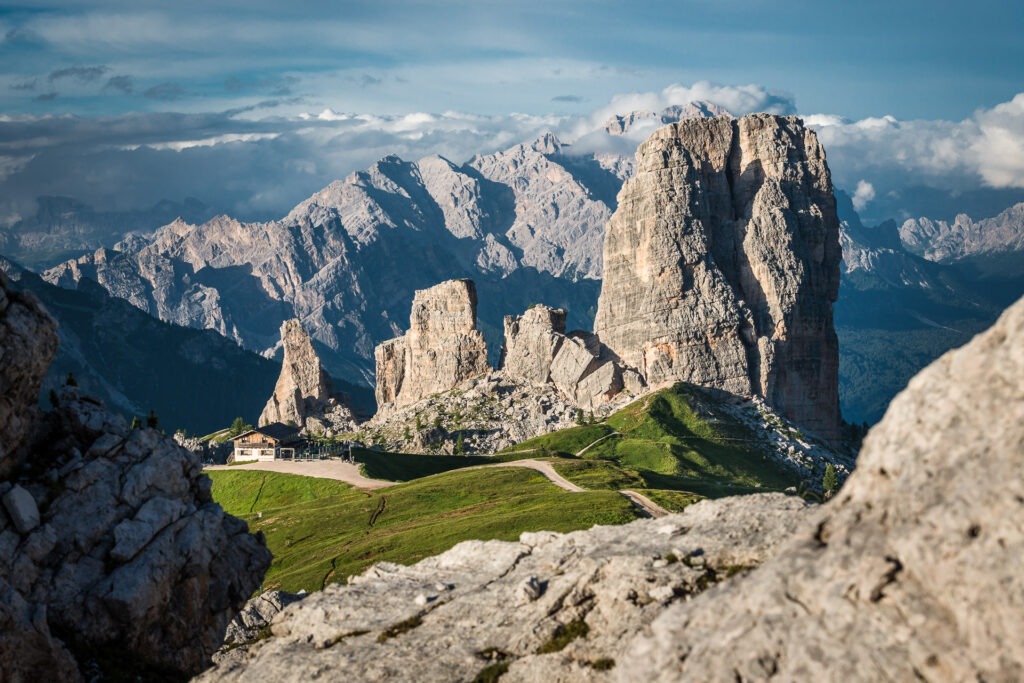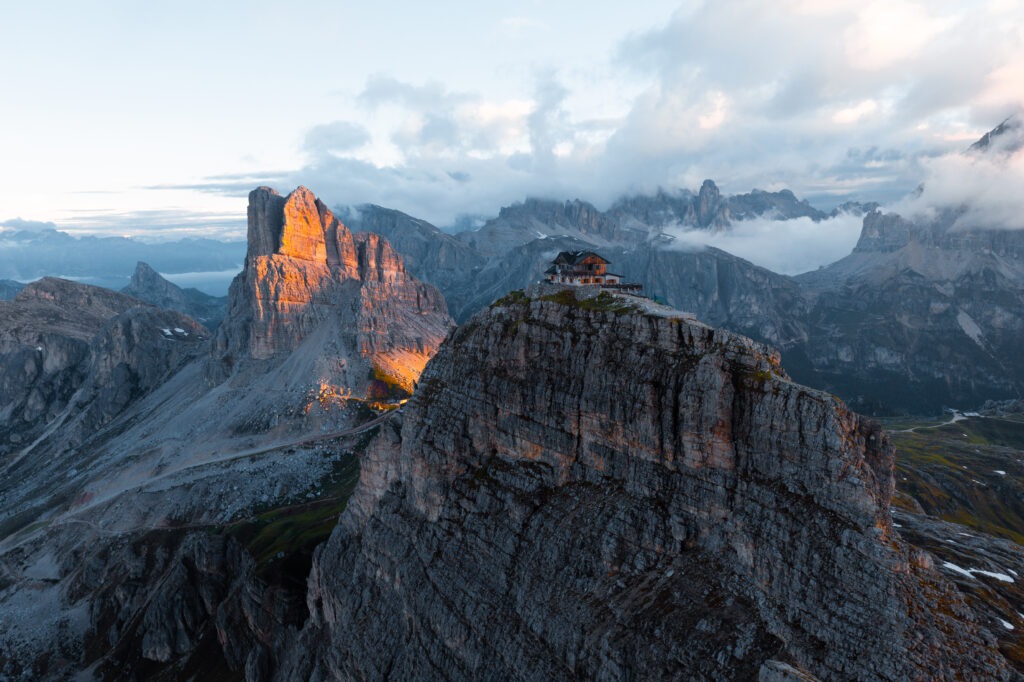Suggested Hiking

THE THREE PEAKS OF LAVAREDO (easy)
Duration: 4 hours
The itinerary starts from Hotel De Len and reaches Rifugio Auronzo. The road is open from late May to late October.
Toll fees:
Car: €30 | Motorcycle: €20 | Camper and vehicles over 2.10 m: €45
Bus up to 30 people: €60 | Bus over 30 people: €120
A wonderful itinerary to discover the majestic Tre Cime di Lavaredo, one of the most iconic symbols of the Dolomites. During the hike, you can enjoy a typical lunch at one of the mountain huts in the area, savouring local specialities like canederli and goulash. The ideal way to appreciate the beauty of the Tre Cime di Lavaredo in summer is by walking the trails surrounding them, observing how their sharp peaks, depending on the viewpoint, gradually transform into softer shapes, eventually giving the impression that the three peaks merge into one.
EXPLORE THE HISTORY OF THE AREA!
This area is a true “open-air museum”, as it preserves tunnels, bunkers and old barracks dating back to the First World War. The Three Peaks are also an important part of the history of international mountaineering: here the first routes were climbed in the thirties.

GORES DE FEDERA E CRODA DA LAGO
Duration: 5 hours
From Hotel De Len, you reach the car park located 50 metres above Lake Pianozes, the starting point of the hike.
The Gores de Federa (Federa Gorges) trail is a recently created path by the Regole d’Ampezzo, which winds through the Federa Forest and leads to Malga Federa. The hike begins on a paved road, reaching Col Purin after about 45 minutes of uphill walking from Lake Pianozes. Here, you’ll find a wooden sign indicating the diversion to the Gores de Federa trail.
The path winds through the Federa Forest, alternating between ascents and descents along waterfalls, gorges, and streams. Along the way, you’ll cross several suspension bridges over the Ru Federa and encounter panoramic viewpoints offering breathtaking views of the Ampezzo basin. After approximately an hour and a half of walking, you’ll arrive at Malga Federa, where you can admire a spectacular panorama: the Becco di Mezzodì on one side, and the Pomagagnon, Cristallo, and Faloria on the other.
After a short break to recharge, continue along trail no. 432 until you reach Rifugio Croda da Lago. From here, you can either return via the same path or complete a circular route by heading back to the starting point along the paved road.
You can also reach Croda da Lago by shuttle, departing from Lago Pianozes.

LAGO DI SORAPIS
Duration: 4 hours
Starting from Hotel De Len, you need to drive to Passo Tre Croci, which is about 20 minutes away by car.
The hike to Lake Sorapis is one of the most captivating routes in the Dolomites. This lake is famous for its intense colour, which ranges from azure to aquamarine, due to fine rock particles carried by the nearby glacier. During the spring and summer thaw, these particles give life to the lake and its defining hue.
Starting from Passo Tre Croci, the hike follows trail no. 215. The route is varied and scenic, with gentle ups and downs and a moderate overall elevation gain. You pass through a forest with stunning views of Cristallo, Popena, the Cadini di Misurina, and the Tre Cime di Lavaredo. After a flat section, there is a more challenging part with some metal ladders and short exposed sections on a ledge, equipped with safety ropes. After these brief passages, you soon reach Rifugio Vandelli, a welcoming mountain hut nestled in the heart of an impressive natural amphitheatre on the northern side of Sorapis, right next to the waterfall that cascades down from the rocky ledge.
EXPLORE THE HISTORY OF THE AREA!
From the refuge, originally built in 1890, you can admire views to the north of the Tre Cime di Lavaredo, Lake Misurina, and, not far away, the magnificent small alpine lake nestled in the mountain, dominated by the striking Dito di Dio (2,603 m). The lake, carved into the rock and without surface outlets, feeds the large rocky threshold of the glacial plateau underground, giving rise to the “el Piss” waterfall. This very waterfall gives the mountain group its name, “Sora el Piss,” which means “above the Piss.”
In winter, the waterfalls freeze, offering enthusiasts the chance to engage in ice climbing.
For the return, it is recommended to follow the same route as on the way up, along trail no. 215.

5 TORRI (easy)
Duration: 2 hours (or longer way +1.30h)
From Hotel De Len, head to the Bai De Dones car park, in the direction of Passo Falzarego. From here, you can either take the chairlift up to Rifugio Scoiattoli, which takes just a few minutes, or continue on foot, with a hike of about an hour and a half.
Once you reach Rifugio Scoiattoli, an ideal spot for a delicious lunch, you can proceed towards the Cinque Torri, which will be right in front of you. At this point, simply follow the signs for the museum trail.
EXPLORE THE HISTORY OF THE AREA!
During the First World War, the area around the Cinque Torri was occupied by the Italian army, which established the artillery headquarters there. To prevent an Austrian counterattack, the Italians prepared a defensive line at the base of the Cinque Torri. Thanks to the unique view of the surrounding mountains, all military actions in the area could be closely monitored.
A few hundred metres from the refuge is the Cinque Torri open-air museum, featuring perfectly restored trenches and positions from the Great War, along with numerous information points and spectacular views of the Cinque Torri. These mountains are also a famous climbing area, featuring the most renowned and historically significant climbing wall in Cortina. With over 200 equipped routes of varying difficulty and length, the Cinque Torri can rightfully be considered among the classic climbing walls of the Dolomites and the Alps.
On the east side of the towers, you can explore the well-preserved trenches of the ridge that descends eastward until it meets the paved road, or continue along the path to reach Rifugio Cinque Torri. This family-friendly refuge is located at the top of a paved road descending into the forest. Follow the road until, at a hairpin bend, you take trail no. 425, which leads you through the forest to Lake Bai de Dones. It is said that this small body of water, offering a beautiful view of the Tofana di Rozes, was once home to the Anguane, water nymphs from local tradition with magical powers and the ability to summon storms.
EXPLORE THE HISTORY OF THE AREA!
Inaugurated in 1904, Rifugio Cinque Torri is one of the oldest and most historic huts in the area. Over the years, it has been visited by royalty and princes from around the world, including King Vittorio Emanuele III. Today, it continues to attract international climbers. To relive the atmosphere of the early 1900s, when climbers from around the world began to discover the wonders of the Dolomites, it’s worth sitting down to enjoy traditional recipes, warmed by the heat of the large ceramic stoves. Among the unmissable specialities are the traditional canederli, bread dumplings filled with speck, cheese, or spinach, served with melted butter and parmesan, and the delicious ricotta strudel.
For the return from Rifugio Cinque Torri, there are two options: you can head back and take the chairlift down to the car park or choose to walk along an easy downhill path leading directly to the car park. Along the way, you’ll be treated to spectacular views of the majestic Tofane to your right, enjoying the peace and freshness of the surrounding natural environment.
A few minutes from Rifugio Bai de Dones, at the junction with trail no. 425, there is a small path leading to the romantic Lake Bai de Dones, whose name means “women’s bath.” According to legend, the lake is home to the Anguane, water nymphs from the Ladin-Ampezzan tradition, whose beauty is only marred by their goat-like hooves. It is said that after a downpour, the rivers become so impetuous that the lake turns murky, as the Anguane wash their clothes high up. There are good Anguane, who protect men with benevolence, and bad Anguane, ambiguous and mysterious, feared like witches. It is believed that Lake Bai de Dones is home to the good Anguane, who help women longing for a child; immersing oneself in its magical waters is thought to bring the joy of motherhood.
An illustration of these mythical creatures, servants of the god Silvanus, can be admired at the entrance to Rifugio Bai de Dones, which takes its name from this enchanting lake.

RIFUGIO NUVOLAU
The oldest rifugio in Cortina
Duration: 5 hours
Starting from Hotel De Len, head to the car park at Passo Giau.
From the car park, take trail no. 443. On your left, you will see the imposing and jagged walls of Ra Gusela, while to the right, you will spot the profiles of Croda da Lago and the Lastoi de Formin. The route is varied and fascinating, alternating between forested sections and open spaces, with numerous panoramic viewpoints. In about an hour, the path winds steeply along switchbacks on the Crépe dei Ronde. Upon reaching the top, you’ll find yourself in an open area with views of the Cinque Torri and, in the distance, Rifugio 5 Torri. From here, you can either pass by the refuge or keep to the left, heading directly to Rifugio Scoiattoli. In both cases, you will intersect with trail no. 439, which you should follow to Rifugio Scoiattoli, located at 2,255 metres, offering a splendid view of the Cinque Torri.
Continuing on trail no. 439, you’ll reach Rifugio Averau, enjoying a breathtaking view of Cortina during the ascent. From Rifugio Averau, in less than an hour and still following trail no. 439, you will arrive at Rifugio Nuvolau.
After soaking in the natural beauty, you can retrace your steps along the same trail back to Rifugio Averau, with the majestic Monte Averau rising behind it. This refuge is famous for its excellent cuisine and features a beautiful panoramic terrace. From here, follow trail no. 464 towards Rifugio Fedare, crossing the pastures of Passo Giau, beneath the chairlift. At the junction with trail no. 452, take it: it will lead you to the foot of Mount Nuvolau and Gusela del Nuvolau, eventually returning you to Passo Giau. If you look up towards the summit of Monte Nuvolau, you’ll spot the namesake refuge, which has welcomed hikers, climbers, and alpine guides since 1883.
EXPLORE THE HISTORY OF THE AREA!
Rifugio Nuvolau, with its authentic and traditional atmosphere, is the first refuge built in the Ampezzo valley, dating back to 1883. Located at 2,575 metres on Monte Nuvolau, it offers a spectacular 360° view of the Ampezzo valley, with the Cinque Torri group below, the Tofane, and the Marmolada range.
The idea to build the refuge came from Colonel Meerheimb of Dresden, who, after staying in Ampezzo and recovering from a serious lung disease, donated a contribution to the local section of the German-Austrian Alpine Club for its construction. For this reason, the refuge was initially called Sachesendankhütte (“Saxon Gratitude Hut”).


